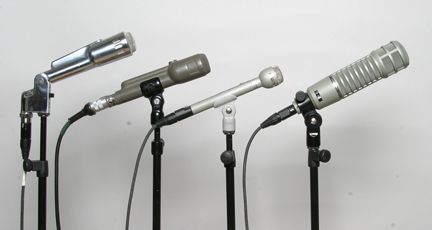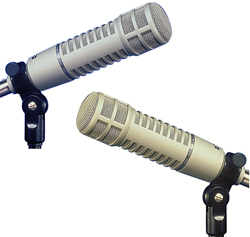The Electro-Voice (EV) model 664 microphone, introduced in the mid-1950s, was designed for typical sound reinforcement applications of that era.
EV employees with the company at the time recall that one of the reasons for the 664’s development was to answer the considerable success of the Shure model 55 (Unidyne).
Yet the 664 was hardly an imitation. It’s the first microphone to employ the company’s renowned Variable-D design principle, which is still at the heart of some EV mics popular to this day.
Patented by Alpha (Alphie) M. Wiggins in 1963, Variable-D mics use frequency selective rear ports to achieve a cardioid pattern. This results in considerably less proximity effect in comparison to single-D designs.
Whether this is a positive or a negative is in the ears of each beholder, but suffice to say that Variable-D has earned its place in the “microphone hall of fame.” (Well, if one actually existed.)
The 664 also earned the nickname “Buchanan Hammer,” a moniker paying homage to the company’s then headquarters in Buchanan, Michigan as well as some serious durability.
Word has it that EV co-founder and mic guru Lou Burroughs would demonstrate the 664’s ruggedness by smacking it on a two-by-four board. A later (unconfirmed) demo reportedly had Lou using the mic to actually drive a nail into the board.
The model 635A later assumed the “hammer” nickname, but it pales in comparison: think tack hammer versus framing hammer. However, the 635A did carry on the tradition of being able to withstand brutal punishment. (Editor’s Note: while working at EV, I indeed drove large nails into boards with the head of a 635A, and it still performed just fine – in addition to providing a chuckle.)
A short time after the 664 debut, EV introduced the models 665 and 666 for broadcast. The 665 looks and feels like a 664, but its finish is non-reflecting gray rather than chrome.

And while the 664 was capable of high- and low-impedance operation, the 665 and 666 were low-impedance only.
The 665’s connector is an XLR instead of the dreaded 91-series Amphenol four-pin used on the 664. Meanwhile, the 666 was the premium broadcast model, outfitted with a Cannon UA series connector (which looks vaguely like an XLR, but is larger and “D shaped”).
Where the 664 and 665 could attach directly to a mic stand, the 666 required a specialized clip.
Although the 666 was discontinued by the late 1960s, it still commands a premium price on eBay, and many live sound engineers still prefer it for kick drum and bass.
It’s also an excellent horn microphone, and I happen to like the 666 (and its newer incarnations) for electric guitar amps.
The subsequent model 667 combined the 666 design with a transistorized preamplifier. This preamp could supply extra gain if needed, and offered equalization switches for the low and high ends of the spectrum.
A separate on/off switch could be used to add in a presence peak, if desired. The preamp used a mercury battery; it predates phantom powering by many years.





















